Waterfalls are abundant in the southern Appalachians. It seems like you can hardly throw a stick without hitting one.
Of course I’ve spent the last 30 years in Yosemite, which might have the most spectacular collection of waterfalls in the world. But they’re different. Yosemite’s waterfalls are big and dramatic, and often leap hundreds of feet in a single drop. The waterfalls in the southern Appalachians are smaller, more intimate, and more complex, often containing multiple tiers and channels. This complexity can make them both more challenging and more rewarding to photograph – challenging because there’s rarely an immediately-obvious composition, but rewarding because once you start looking you might find a dozen or more good compositions in a single cascade.
During our last trip, one of the first places we visited was Minnehaha Falls in northern Georgia. Since this fall is on the cover of two different waterfall guidebooks it seemed worth checking out. And we weren’t disappointed. Minnehaha is graceful enough to lend itself to overall views, and intricate enough to offer many smaller-scale compositions. The day was overcast, which is often ideal for these kind of waterfalls. I spent an hour and a half there working just one side of the cascade before we had to move on.
Later during our workshop we visited several other waterfalls I hadn’t been to before. Among my favorites were Station Cove Falls (or Oconee Falls) and the Brasstown Creek cascades, both in South Carolina. The Brasstown Veil is one of the few vertical drops in the area, which means it generates lots of spray. Spray can mean rainbows in the right light, and we were lucky enough to find a rainbow there during our late-afternoon visit. (A word of warning though: the trail to this waterfall is steep and slippery, so use caution and attempt it at your own risk.)
We also returned to my favorite waterfall from my previous visit, Eastatoe Falls. And I’m glad we went back, as a log that had annoyed us the last time had disappeared, plus there was more moss along the sides of the fall, adding a touch of color.
While the big waterfalls in Yosemite often work with fast shutter speeds, which freeze the motion and show the texture of the spray, the waterfalls of the southern Appalachians often look best with slower shutter speeds, creating soft veils of water flowing over their ledges.
People often ask me what shutter speed to use to blur the motion of waterfalls and cascades, but there’s no single answer. The range is usually from around 1 second to 1/8th of a second, but sometimes even slower or faster shutter speeds can work. A shutter speed of 1 second will make the water look soft and silky, while 1/8th of a second will still convey motion, but preserve more texture in the water. In between you can get a range of effects, depending on the relative speed of the water across the frame, and the structure and flow of the cascade. For these southern-Appalachian waterfalls I often preferred slow shutter speeds to create a soft, silky look and enhance the “veil” effect, but not always. It pays to experiment with different shutter speeds, and when you find the right one, take a number of different frames with the same composition and settings, as the water is constantly changing, so you’ll get a different look with each exposure. (Of course you need to use a tripod with shutter speeds this slow; you want to blur the water, but not the rocks!)
Also, I don’t think I made a single exposure of a waterfall without a polarizing filter. The polarizer cuts the sheen on the wet rocks, darkening them, enriching colors, and enhancing the contrast between the rocks and white water. The only exception was the rainbow on Brasstown Veil, where I still used the polarizer, only I rotated it 90 degrees from its usual reflection-cutting orientation to enhance the rainbow.
Aside from these technical considerations, I really worked each waterfall, and encouraged my workshop students to do the same. There’s a saying in chess: “When you find a good move, look for a better one.” In photography, when you find a good composition, go ahead and take it – but then look for a better one.
Invariably, my first photograph of a waterfall didn’t turn out to be my best. But I kept working each scene, trying different ideas, and variations of those ideas. In several cases, my last composition of a waterfall turned out to be the best.
And, as always, I looked for patterns. Repeating patterns help unify a photograph and create rhythm and order, and patterns were abundant in the tiers and braids of these waterfalls if you looked for them.
Of course we just dented the potential here. There are literally hundreds of waterfalls in this area, and the creative possibilities are endless. I look forward to going back!
— Michael Frye
Related Posts: Back From the Southern Appalachians; Along the Blue Ridge Parkway
Did you like this article? Click here to subscribe to this blog and get every new post delivered right to your inbox!
Michael Frye is a professional photographer specializing in landscapes and nature. He is the author or principal photographer of The Photographer’s Guide to Yosemite, Yosemite Meditations, Yosemite Meditations for Women, and Digital Landscape Photography: In the Footsteps of Ansel Adams and the Great Masters. He has also written three eBooks: Light & Land: Landscapes in the Digital Darkroom, Exposure for Outdoor Photography, and Landscapes in Lightroom 5: The Essential Step-by-Step Guide. Michael written numerous magazine articles on the art and technique of photography, and his images have been published in over thirty countries around the world. Michael has lived either in or near Yosemite National Park since 1983, currently residing just outside the park in Mariposa, California.

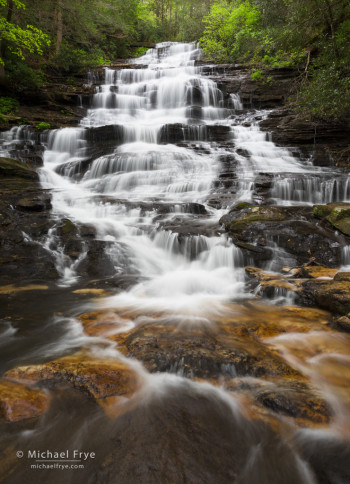
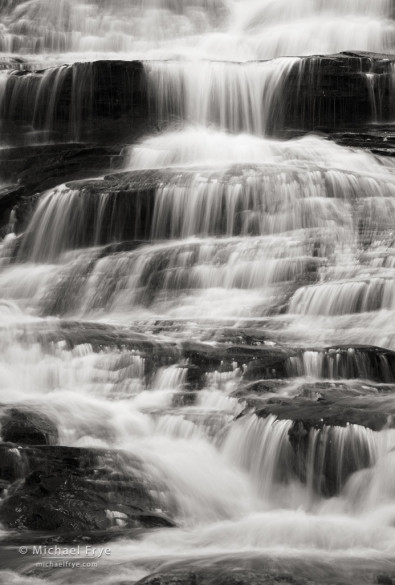
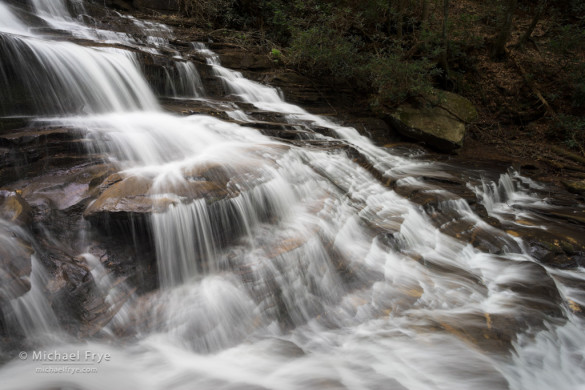
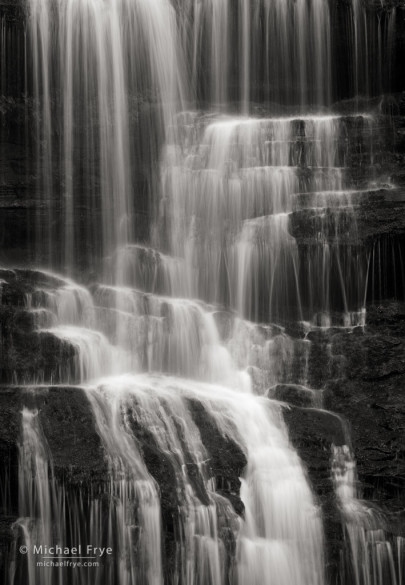
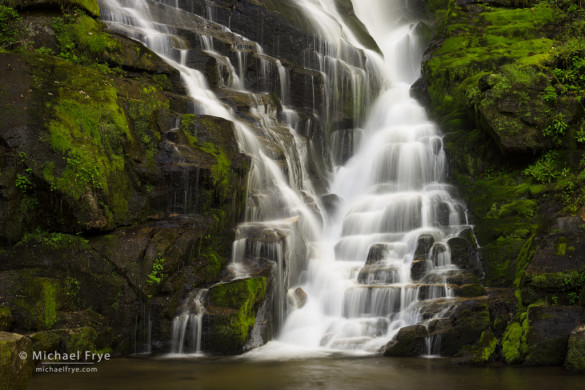
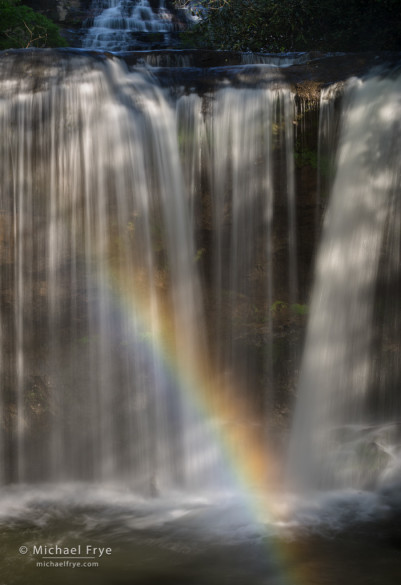
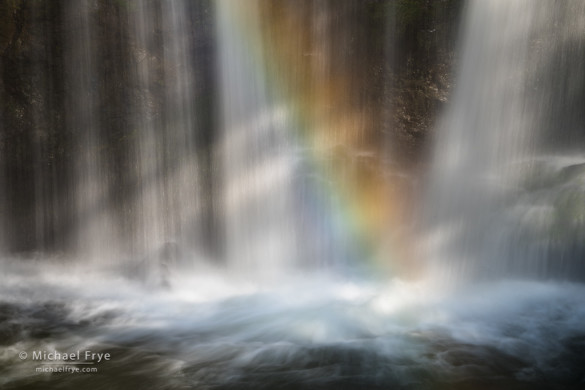
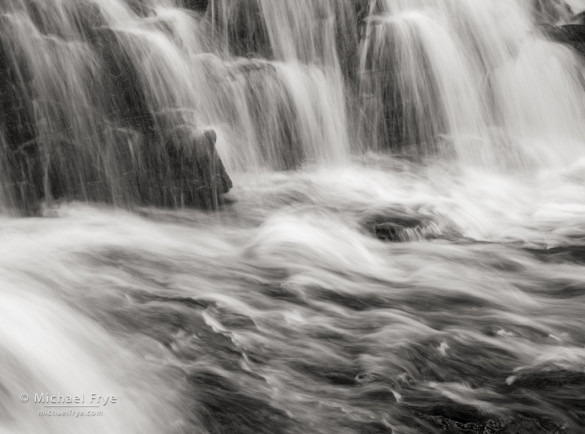








Great article! I love shooting moving water but I have always used a circular neutral density filter for this. Why do you use a polarizer instead of Nd filter?
Thank you Jennifer! As I explained in this post, a polarizer cuts reflections. A neutral-density filter doesn’t – it cuts the total amount of light, which allows you to use slower shutter speeds, but it doesn’t do anything to reflections. A neutral-density filter is not usually necessary for photographing waterfalls in the shade, as the light is usually dim enough to get a slow shutter speed. If a waterfall is in the sun, then yes, a neutral-density filter might be necessary to cut the total amount of light, and allow you to use a slow shutter speed. But a polarizer helps with most waterfalls whether they’re in the sun or the shade by cutting that sheen on the wet rocks.
I have many times used a 10 stop ND with a C-PL precisely for reasons mentioned above. While this drastically cuts the light down even during the mid-day sun, I have to be careful with my B+W ND because it imparts a brownish tint to the shot. Therefore if I fail to make the correction beforehand, I end up with a wrong color cast shot!
Case in point – https://flic.kr/p/8buxBr
Shiva, thanks for your comments. I sometimes use ND filters for waterfalls in the sun, but in the shade they usually make the shutter speeds too slow for my taste. But for other situations, like some ocean scenes, smoothing out the flow of a river, or trying to get wind-blown clouds to blur, a strong ND filter is a great help.
Thanks for validating my approach! Your article was majorly useful. I adore photographing waterfalls, but have never had very excellent composition. I feel, I also err in processing while trying to bring more dynamic range in the water and avoid blowing it out. Any tips on that front?
I’m not sure what you mean by “trying to bring more dynamic range in the water and avoid blowing it out.” Processing waterfalls is no different than processing any other image, but processing in general is a complex subject, and I delve into it in depth in my Landscapes in Lightroom 5 ebook.
Michael, excellent post. Wonderful images. What town(s) did you use as your base of operations? Best regards, Barry
Thanks Barry! My students were based in the Clemson-Seneca area of SC, and we also spent a night in Cherokee, NC, and two nights at the Mount Pisgah Inn along the Blue Ridge Parkway.
I would love to hear your take on photographing along Blue Ridge Parkway during fall! It has been on my to-do list for a very very long time.
Shiva, I haven’t photographed the Blue Ridge Parkway in the fall, but I’m sure it’s great!
Lovely set Michael. I spent some time up in NC some years ago. It’s a beautiful part of the world.
Thanks Malcolm, and it is indeed a beautiful area.
I was wondering, with all that waterfall photography, did you take any spills out there on any of those slick mossy rocks in the stream ? I sure have (more than once) when moving around for that “perfect” composition. By the way, Rainbow and sunbeams gets my vote as favorite image of this post!!
Thanks Jeremy, and yes, I did slip at one spot below Brasstown Veil. Those rocks around streams and waterfalls can definitely be slippery.
Your composition of Station Cove Falls is truly fantastic! It’s very different from the usual waterfall shot.
If you make it back to this area again and have time, I’d like to suggest two falls in Middle Tennessee (not Central – there is NO central part of Tennessee!). They would entail an overnight stay from your base, being that they’re a good drive from the Blue Ridge. Fall Creek Falls is the highest free falling waterfall east of the Rockies and Burgess Falls has a power and size reminiscent of Niagra Falls. That whole area of Tennessee is worth a visit for any photographer.
Blake, thanks for the kind words and the suggestion!
That is an incredible collection of shots. I can’t believe you captured so many 1st class images in such a short amount of time. And if these are from the new Sony, I’d say you mastered the thing. 🙂
Thanks very much Kevin. I’ve had so much experience working with so many cameras during workshops that it’s easier for me to adapt to a new camera than most people, but it did take awhile for the controls on the Sony to become intuitive enough for me to not have to think about them.
Michael,
Wonderful images. And interesting info on how you were shooting the waterfalls.
Doug
Thank you Doug!
Michael, I recently bought your e-book on processing landscape images in Lightroom 5. I have been using Lightroom for a couple of years but greatly benefited from reading the book and watching the accompanying videos, which are very well done. I am going back and reprocessing many of my RAW files using the suggestions in your book and am much happier with how they look.
I live in Western North Carolina and am glad you enjoyed your trip to this part of the country. In the last couple of years I have photographed probably 200 waterfalls in WNC, upstate South Carolina, north Georgia and eastern Tennessee including all of the ones you reference in this blog entry except for Trahlyta Falls which I’ll have to look into. If you are ever headed back this way and looking for places to shoot, both waterfalls and other landscapes, let me know. You could easily get to and photograph 25-30 very good to spectacular waterfalls in NC, SC and GA in 4 or so days based out of Cashiers or Highlands. For a mixture of waterfalls and mountain landscapes, the Linville Gorge/Grandfather Mountain area northeast of Asheville along the Blue Ridge Parkway is another great area to photograph. And of course there’s the Great Smoky Mountains National Park.
Thanks Don – I’m glad you’ve found the ebook helpful! And thanks also for the suggestions. I’m sure I’ll get back to that area sometime, and I look forward to seeing more waterfalls – and other things. For what it’s worth, I didn’t think Trahlyta Falls was terribly photogenic. I mean it’s nice enough, but some logs disrupted some of the more interesting sections, and I had to work pretty hard to find the composition shown here.
Hi Michael, I love your waterfall photos! Do you sell prints of any of these on this page? I hope so! If so, where would I purchase one? Thanks!
Thanks Alicia! Yes, any image you see on this site is available as a print directly from me. I’ll email you with available sizes and prices.